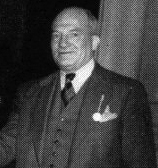
Exposition Park was the name given to three historic stadiums, located in what is today Pittsburgh, Pennsylvania. The fields were used mainly for professional baseball and American football from c. 1879 to c. 1915. The ballparks were initially located on the north side of the Allegheny River in Allegheny City, Pennsylvania. The city was annexed into Pittsburgh in 1907, which became the city's North Side, located across from Pittsburgh's downtown area. Due to flooding from the nearby river, the three stadiums' exact locations varied somewhat. The final version of the ballpark was between the eventual sites of Three Rivers Stadium and PNC Park.

A panther is the animal that serves as the official mascot of the University of Pittsburgh and used as a nickname for both athletic teams as well as other organizations and affiliates of the university. The mascot is generally referred to as the Pittsburgh Panther or Pitt Panther, while the costumed panther mascot is also named "Roc". Up to 20 physical representations of panthers can be found in and around the university's campus and athletic facilities.

The University of Pittsburgh, commonly referred to as Pitt, is an independent, state-related, doctoral/research university in Pittsburgh, Pennsylvania, United States. For most of its history, Pitt was a private institution until it became part of the Commonwealth System of Higher Education in 1966.

David Hunter Riddle was the ninth and last president of Jefferson College from 1862 until its union with Washington College to form Washington & Jefferson College in 1865. He also served as trustee and the acting Principal of the Western University of Pennsylvania, today known as the University of Pittsburgh, from 1849 to 1855.
The Allegheny Athletic Association was an athletic club that fielded the first ever professional American football player and later the first fully professional football team. The organization was founded in 1890 as a regional athletic club in Allegheny, Pennsylvania, which is today the North Side of Pittsburgh.

Bertrand Hunter Smyers was an attorney and, along with fellow student John Scott, founder of the University of Pittsburgh's football program. Smyers is also considered to be the University's first quarterback.

JohnMoore Van Cleve was an American football player and coach. He became one of the earliest known people paid to play the sport when he, Ollie Rafferty, and Peter Wright signed contracts with the Allegheny Athletic Association for $50 per game for the entire 1893 season. Only Pudge Heffelfinger and Sport Donnelly are known to have been professionals earlier.
American football in Western Pennsylvania, featuring the city of Pittsburgh and surrounding areas, has had a long and storied history, dating back to the early days of the sport. All levels of football, including high school football and college football, are followed passionately, and the area's National Football League (NFL) team, the Pittsburgh Steelers, is consistently one of the sport's most popular teams. Many of the NFL's top stars have come from the region as well, especially those that play quarterback, earning Western Pennsylvania the nickname "Cradle of Quarterbacks".
The Western Pennsylvania Professional Football Circuit was a loose association of American football clubs that operated from 1890 to approximately 1940. Originally amateur, professionalism was introduced to the circuit in 1892; cost pressures pushed the circuit to semi-professional status from about 1920 through the rest of its existence. Existing in some form for 48 years, it was one of the longest-lived paying football loops to operate outside the auspices of the National Football League.

The 1901 Western University of Pennsylvania football team was an American football team that represented Western University of Pennsylvania as an independent during the 1901 college football season.
The 1902 Western University of Pennsylvania football team was an American football team that represented Western University of Pennsylvania as an independent during the 1902 college football season. The Pitt Football Record Book refers to a 24–0 victory over Bucknell. However, contemporary press coverage indicates that the game was played between Bucknell and a team known as "the Pittsburgh stars".

The 1898 Western University of Pennsylvania football team was an American football team that represented the Western University of Pennsylvania as an independent during the 1898 college football season.
The 1897 Western University of Pennsylvania football team was an American football team that represented the Western University of Pennsylvania as an independent during the 1897 college football season.
The 1896 Western University of Pennsylvania football team was an American football team that represented the Western University of Pennsylvania as an independent during the 1896 college football season.

The 1895 Western University of Pennsylvania football team was an American football team that represented the Western University of Pennsylvania as an independent during the 1895 college football season.
The 1893 Western University of Pennsylvania football team was an American football team that represented the Western University of Pennsylvania as an independent during the 1893 college football season.

The 1894 Western University of Pennsylvania football team was an American football team that represented the Western University of Pennsylvania as an independent during the 1894 college football season.
The 1890 Western University of Pennsylvania football team was an American football team represented Western University of Pennsylvania—now known as the University of Pittsburgh—as an independent during the 1890 college football season.

The 1891 Western University of Pennsylvania football team was an American football team that represented the Western University of Pennsylvania as an independent during the 1891 college football season.

The 1892 Western University of Pennsylvania football team was an American football team that represented the Western University of Pennsylvania as an independent during the 1892 college football season.












